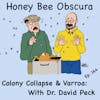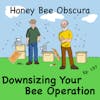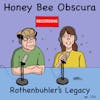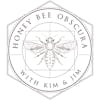Winter Chores: Culling Combs (155)

In this episode of Honey Bee Obscura, Kim and Jim delve into several important maintenance tasks that beekeepers can undertake during the winter season to ensure the health and productivity of their hives. Winter might seem like a downtime, but it's a...
In this episode of Honey Bee Obscura, Kim and Jim delve into several important maintenance tasks that beekeepers can undertake during the winter season to ensure the health and productivity of their hives. Winter might seem like a downtime, but it's a critical period for preparing your hives for the upcoming spring.
One key task they discuss is culling old comb. This task is near and dear to Kim. It involves removing combs that are over three years old or show signs of disease, pest infestation, or excessive use. By doing this, you reduce the risk of diseases, pests, contaminants and residual pesticides, and enhance the hive's overall cleanliness. It's a vital step in maintaining hive health and vigor.
Other essential winter chores, include checking and repairing hive equipment, cleaning and storing unused equipment, and planning for the upcoming season. Monitoring food stores and ensuring adequate insulation are also discussed, ensuring your bees stay healthy and well-fed throughout the colder months.
Listen today and gain valuable insights and tips on winter maintenance. It’s a vital aspect of beekeeping that sets the stage for a successful and bountiful year ahead.
______________________

Thanks to Betterbee for sponsoring today's episode. Betterbee’s mission is to support every beekeeper with excellent customer service, continued education and quality equipment. From their colorful and informative catalog to their support of beekeeper educational activities, including this podcast series, Betterbee truly is Beekeepers Serving Beekeepers. See for yourself at www.betterbee.com
______________________
Honey Bee Obscura is brought to you by Growing Planet Media, LLC, the home of Beekeeping Today Podcast.
Music: Heart & Soul by Gyom, All We Know by Midway Music; Christmas Avenue by Immersive Music; original guitar music by Jeffrey Ott
Cartoons by: John Martin (Beezwax Comics)
Copyright © 2023 by Growing Planet Media, LLC

Episode 155 – Winter Chores: Culling Combs
Kim Flottum: Hey, Jim, I see you're looking busy. What have you been up to?
Jim Tew: Really, Kim, not much of anything. It's late season, everything's going to bed. We're entering that long, quiet, cold, dark bee spell where you sit around and think about bees, ponder about bees, but don't do much real bee work. That's the time that's coming up.
Kim: Hi, I'm Kim Flottum.
Jim: I'm Jim Tew.
Kim: We're here today at Honeybee Obscura, and we're going to talk about how to stay busy during the off season, and I think we’ll find a way.
Introduction: You are listening to Honey Bee Obscura, brought to you by Growing Planet Media, the folks behind Beekeeping Today podcast. Each week on Honey Bee Obscura, hosts Kim Flottum and Jim Tew explore the complexities, the beauty, the fun, and the challenges of managing honey bees in today's world. Get ready for an engaging discussion to delight and inform all beekeepers. If you're a long-timer or just starting out, sit back and enjoy the next several minutes as Kim and Jim explore all things honey bees.
Kim: Jim, what have you been up to lately?
Jim: I have been trying to stay busy. The season's over. I made some honey, got some swarms. Overall, it was a typical bee year. Not my best, not my worst. Now, Kim, I got to tell you straight up, I've had trouble writing articles for it. What do you do in these cold, gloomy months? There's just busy work. You can put some equipment together. You can read some books. You can go to some meetings. Basically, you're just treading water until you can get out with the bees again, right? Put that back on you. What have you been doing, Mr. Busy?
Kim: Are you asking me what I got to do during the down season? I'm sitting here looking at a mountain of frames with old comb that got to get changed, fixed, something. It's a mountain, and it's old comb, and that's what I'm looking at. I'm betting a lot of people should be looking at a mountain of old comb this time of year.
Jim: I don't want to talk about that, Kim. That's one of those jobs that's about beekeeping, but it's not beekeeping. Does that make sense?
Kim: Yes.
Jim: Yes, I know. The fundamental aspect of our concept of modern beekeeping is you're able to pull those combs out, have a look, make decisions about your bees, and then put the comb back. Those combs and those frames need to be in working order, and they do have a limited life to them. If you've taken on that winter task of organizing, sorting, recoding, foundation, or whatever you're doing, you've got your work laid out for you, Kim.
Kim: I do. Every year I go through this. Every year I go through this. Okay, I got a bunch of old comb here, and I'm looking at the comb that is old. The stuff that I chose a couple of years ago, some of it worked really well. Some of it is in chunks, laying on the floor. It didn't work at all. It was, "I'm going to say this carefully," junk, or the bees made it junk, or I made it junk. The stuff I got to replace, I'm looking at, okay, do I want to not use the same stuff, or am I going to use the same stuff? If I am, what are my choices out there? What do you use for combs?
Jim: I have always historically used every conceivable product that was available. In the old days, it was just something like AI Root, three-ply comb foundation. Then some of the other companies made plastic center foundation. Then I guess the most recent thing, and it's not much-- really very recent anymore, it's been around for years, have been these heavy foundation inserts that you can snap into the frame. No wiring, no aisle editing, no island installation, it's quick. My combs are a motley collection of combs that should have been retired years ago, of combs that are fairly recent, of plastic uniframes, or foundation insert outfitted wooden frames. I try to keep them all the same in a box, but between boxes, some of those are not really very similar in product manufacture. I use everything, Kim, just because I want to know what's best and what's worst.
Kim: Yes, I have a golden rule. No, I have two golden rules. One of them is the wax in those frames doesn't last, at the most, three years, usually only two. After two, I got the date written on the top of the frame, and after two years, all the wax in that frame goes away. It goes in a lot of different directions. I do that because I am surrounded by corn and soybeans. As far as you can fly a plane in any direction from my place, it's corn and soybeans.
There's pesticides out there all season long that I'm looking at, my bees are looking at, and that two-year window is about as long as I want that wax being exposed to the pesticides that are being brought back to the hive, maybe. I'm not even positive. I'm betting that there is, after two years, everything goes. The other golden rule I have is no plastic. It's all got to be wax. There's a lot of different ways to make wax, comb, wax foundation in a frame every year, but no plastic and only two years. That really limits my choices. I go from eight pages of foundation and a catalog to one and a half. That's where I'm at.
Jim: There's a style of beekeeping that's really traditional, old beekeeping. The way our fathers and grandfathers and grandmothers did it. That was very minimal foundation, just starter strips, something to guide the bees into the outline of the frame. Then, of course, what we were going to do is just cut that out, that my ancestors would have, but just cut it out of the frame and then use it as cut comb honey or chunk honey.
Kim: Bingo.
Jim: Then you didn't have to have any foundation at all. No wiring, no nothing. All that wiring and foundation support, foundation inserts came about because we want to run those extractors as fast as possible to sling that honey out as fast as possible to get this job over and done with.
Kim: I go back to all those people long ago, I really relate to no foundation at all. Starter strips work well. I'm careful to use those, but you know how I use my starter strip is I take a little bit of comb from a frame I used last year off the bottom. I put that on the top of a frame as a starter strip. All I need is about three-quarters of an inch to an inch. That's all the bees need. I've got wax in there that I'm comfortable with in terms of age. The starter strip, I don't have problems with drone comb on those. I just take that and, bingo, it's worker comb.
Jim: Am I following you? You cut the bottom edge of a piece of comb off and then just tack it probably with heat onto the underside of a top bar. I haven't heard of anything like that since about 1870, but I can see how it would work.
Kim: It works and it doesn't take a lot of time. It doesn't take a lot of energy. I don't waste a lot of wax and I don't do it with everyone. I do it with for as many frames as I've got that are less than two years old that look okay to do this with. That's usually not hundreds, that's tens. The frames that I have that I don't do that with, then I run into problems because it's got to be less than two years old and no plastic. I have trouble with-- you can see, I have trouble, I'm stuttering here because it's, where do I go? I take a half a piece of foundation off a pretty new frame and put it on another one and move on. It's the best I can do, but I'm comfortable with no plastic and no pesticides.
Jim: I admire you for that, but I can't get in the same boat with you just because it's going to be so much work. Plastic is just-- I don't know how to get away from it. It's such an integral part, for better or for worse, of everything in our lives now and in our oceans and everywhere else, but that's a totally separate subject. Let me get my thoughts together here and let's hear from somebody who can sell you nice new equipment and you won't have all these problems.
Advert: Hello, Beekeeping Today podcast listeners. As the year winds down, the team at Better Bee wants to extend a heartfelt thank you for making this another incredible year in beekeeping. Your passion and dedication inspire us every day. To show our gratitude, we're excited to unwrap a special holiday gift just for you. From now until December 15th, 2023, enjoy an exclusive 10% off all orders at betterbee.com with savings up to $150. Just enter the code JOLLY at checkout, that's discount code J-O-L-L-Y, and watch the savings buzz into action. Remember, this offer flies away at midnight Eastern Time on December 15th. Whether you're a seasoned beekeeper or just getting started, Better Bee has everything you need for a sweet holiday season.
From all of us at Better Bee, we wish you a joyous holiday season filled with warmth, happiness, and of course, the sweet home of busy bees. Here's to another year of growth, learning, and sweet success. Happy holidays and a buzzing new year from the team at Better Bee. Don't forget, use the code JOLLY for your exclusive holiday discount. Cheers to the hive.
Jim: I have to tell you that I've always used foundation, but when you were talking, it would be entertaining. I just, I'm keeping bees now for enjoyment. I'd like to get enough honey to have some for myself and have plenty for the bees, but I'm not trying to sell it or do anything anymore with that. Let the other people have that. It would be entertaining to watch those bees build that comb back out naturally. I envision some of the bees are not going to get it right.
They're going to wander out of the frames and you're going to straighten that up. I wonder if you go back, do you bend those wayward combs back in that are not staying within the frames perfectly? Do you just cut them out, make the bees shoot till they win and get it right and rebuild it? Does it depend on the season? If they keep cutting out the combs and telling the bees to redo it and you run through the spring season, they're not going to be doing any comb building to speak of in the hot summer months.
Kim: All of the above, basically. In the spring, I try to be in there as much as possible to keep that from happening. I don't let them get ahead of me, he says carefully, because they do sometimes. If I'm in there twice a week or three times a week at the most, I can stay ahead of them because they're okay, but I'm a little faster. The other thing to keep in mind is on both sides of my frame equipment, I've got a no starter strip, no comb, no anything frame that they draw almost exclusively as drone comb. I'm old-fashioned enough to think that drone comb in a hive that I take out is going to get rid of some of the varroa mites in that colony. Am I still right on that?
Jim: Is there drone brood in that comb?
Kim: Yes.
Jim: Oh, yes. You are right. I think you are. I think you're using drone-size comb for honey storage, but it actually has drone brood in it. To my understanding, if you're taking out that drone comb, you're taking out a significant percentage of the varroa population. All of a sudden this topic's taking a right-hand turn. I'm trying to think about frame recovery and all of a sudden, you're jerking an old man around here.
Kim: It's one thing I do without even thinking about it. It's two drone combs in every brood blooper and then honeycombs in between with starter strips or whatever. It's messy, but I go back to my two golden rules and I don't have pesticides in my hive and nothing over two years.
Jim: No plastic. I didn't know you didn't do plastic.
Kim: Exactly. No plastic.
Jim: You don't want to come around my hives because I explore everything. Those foundation inserts, sometimes I should just say nobly and quietly, but I would not be telling the complete truth. I can't do two years, Kim. I try to start at three by four. It really needs to be done. When I'm suddenly overwhelmed with energy and enthusiasm, I've got a wide scraper used to take wallpaper off of walls and I just cut that comb right back down to that foundation insert. This is not my idea. I got it all off of the web. Then I went over to the second-hand store and bought a crock pot.
Then I milled enough wax in that to put a three-inch paint roller in. Then you just roll that thin film of beeswax back on that banged-up, mottled-up foundation insert and give the bees some starting comb there. They'll do a pretty good job of rebuilding back on that sheet and put their comb on it. In my case, my three to four-year-old comb is gone away and you recycle that out. That's one of the things that I'm doing. None of that was my idea. That was all somebody else's idea, something similar to it. If you don't have any foundation at all, do you try to extract from that or are these frames just what you use for cut comb honey, or you leave it for brood and don't do anything with it?
Kim: Cut comb honey. That's where the money is. I don't make enough to sell. The people that I share my honey with are looking to cut comb honey. A common response is, "Oh my God, I haven't had this since I was 10 years old." That's the people that I like sharing my honey with. A lot of it's cut comb honey. I don't try to extract. I don't even own an extractor. Some of my frames, I will admit, I will share with a friend who has an extractor to get some liquid honey out of it. Often he'll blow the frame out. He'll blow the wax out. I don't care. We'll just harvest the wax and move on. I do get some liquid honey. I get some cut comb honey. At the end of the season, I'm happy.
Jim: You haven't really lost anything. It's messy. It can be a headache for your friend, I guess, because he's got to take that blown comb out of the piping before it gets to the honey or you're going to have big chunks of wax in there. He's probably got a filtering system set up that would take all that out or take most of it out. It's not like you've destroyed a high-dollar frame that you've got a foundation insert in and you've done all these things to make a nice comb for it and then it blew up in the extractor. If you've got really no energy in it, your energy, got the bees' energy in it, then it's not a great loss for you. I can see that.
Kim: That filter that he uses, you're talking to right now, I'm the guy at the end of the line there that's trying to catch all this stuff and getting it out of the sight. I give him a hand when he extracts my stuff so that he doesn't have to end up with that mess. I got to ask you one more thing. Do you ever use wax, the traditional wax foundation?
Jim: I have not used it in a long time, Kim. I have some back in my barn right now. It's becoming antiquey. You can still buy it right now, Kim, and listeners. I think you can still buy everything. The wiring, the wiring board, the eyelets, the embeddable foundation. You can go back to 1957 and keep bees the old way with that thing. I don't ever use it, Kim. Here's the truth. I have increasingly, reluctantly gone to the snap-in foundation inserts just because I guess I'm lazy.
Kim: Time and energy.
Jim: All of those old tasks are gone. All that sitting around a wood-burning stove in the winter with the smell of beeswax and pine in the air and snapping, putting those together, and embedding, all of that process is gone. You just snap it in, plastic, and it's the new wave of plastic beekeeping, I guess.
Kim: Yes, I think so. I had a friend come over the day before yesterday, I think it was, and I was working in the garage on frames. It's almost Thanksgiving, and it's 60 degrees out today. I'm working in the garage with the garage door open. This is summer. It's great. I was working in the garage, working on doing this framework here. A friend of mine comes over and hops out of his car, walks into the garage, and he's looking around all my-- earlier we were talking about how many supers I've got that I'm not using. There's these mountains of supers over here, mountains of frames over here. Here I am working on frames, putting in some wax, and he picks up a frame, and he's looking at it, and he says, "What are these two holes for on each side?"
Jim: Oh, no, don't tell me that. How old are you, Kim? How old are you? What are those two holes for, and end bars for?
Kim: Yes. I got some frames that are that old. I don't have wax that are that old, but I got some frames that are that old.
Jim: When you were talking a bit ago about throwing frames away, I've got some sentimental frames. I'll tell you the truth. They're frames made by companies that don't exist anymore, and I just cannot bring myself to throw them away. I'm not going to do anything with them. I'm just going to put it back in the beehive since my bees are not top-notch anyway. I need to let you go, Kim. I know that I'm holding you up on all this chatting. I'm telling you I'm not going to work as hard as you are on this frame selection thing, but it is a good winter job to do during the winter when you're trying to stay busy and disrupt all the mice that wanted to live inside those boxes while they were hiding out for the winter, and here you are.
Kim: It's still 60 degrees out today. I'm going to enjoy the rest of the day. We'll catch you later.
Jim: All right. Hey, buddy, thanks for talking to me.
[00:19:18] [END OF AUDIO]
New to Honey Bee Obscura Podcast?
Here are some great episodes to start with. Or, check out episodes by topic.







 In this episode of Honey Bee Obscura, Kim and Jim delve into several important maintenance tasks that beekeepers can undertake during the winter season to ensure the health and productivity of their hives. Winter might seem like a downtime, but it's a critical period for preparing your hives for the upcoming spring.
In this episode of Honey Bee Obscura, Kim and Jim delve into several important maintenance tasks that beekeepers can undertake during the winter season to ensure the health and productivity of their hives. Winter might seem like a downtime, but it's a critical period for preparing your hives for the upcoming spring.





